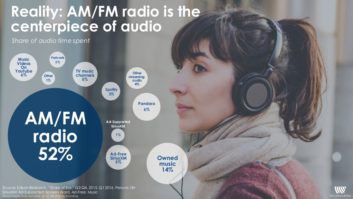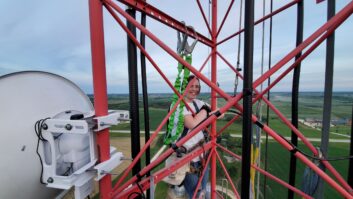Smartphone ownership is having a sizable impact on online radio listening. That was the message from Larry Rosin, president of Edison Research, who shared statistics and research on the state of affairs of the mobile phone and audio at the RAIN Summit here in Las Vegas this week.
During the session “Share of Ear on the Smartphone,” Rosin offered some eyebrow-raising statistics on smartphone usage — for example, a whopping 87% of adults 18 to 34 never let their smartphone leave their sides. Rosin said the smartphone has created a new mobility for audio usage.
It’s no surprise that smartphones are being used for more and more things, he said; as a result there is a correlation between online radio listening and smartphone ownership. Of smartphone users who listen to audio on their device, 54% of that time is spent listening to a radio broadcaster’s online streams, 16 to owned music, 15% to “pureplay” streaming audio, 7% to Sirius XM, 5% to TV music channels and 2% to podcasting.
For those who listen to audio on their smartphone, they consume an average of two hours every day. And during that day, 43% listen to their own music, 37% listen to streaming audio, 9% listen to AM/FM radio and 7% listen to podcasts.
That AM/FM listening drops depending on age. Young listeners spend almost an equal amount of time listening to streaming audio and owned music while only spending about 6% of their time listening to AM/FM radio.
And the predictions for young children may be surprising, Rosin said. Some predictions say a child from a middle-income family may get a phone as young as 10 years old. As she grows, her home may not even have a single traditional AM/FM radio, while odds are almost 100% that she’ll have high-speed connectivity through Wi-Fi or through her phone.
“She may love audio, but in her home, she’s likely to access it through a Sonos system or Alexa interconnected television,” he said, referring to the wireless interconnected speaker system and Amazon voice-controlled Bluetooth speaker, respectively.
The young of tomorrow will most likely be well-versed in the downloading of apps and connecting to broadband networks.
“Long before she gets there, she will know how to put Kids Bop or Radio Disney on a radio system,” Rosin said. “It’s going to be audio that she controls.”
As he wrapped up the session, Rosin asked the audience to consider the changes that are forthcoming when it comes to audio, smartphones and interconnected automobiles. “The big outstanding question is going to happen in the in-car environment,” he said. “Are you going to continue to doubt that things are going to change?”







